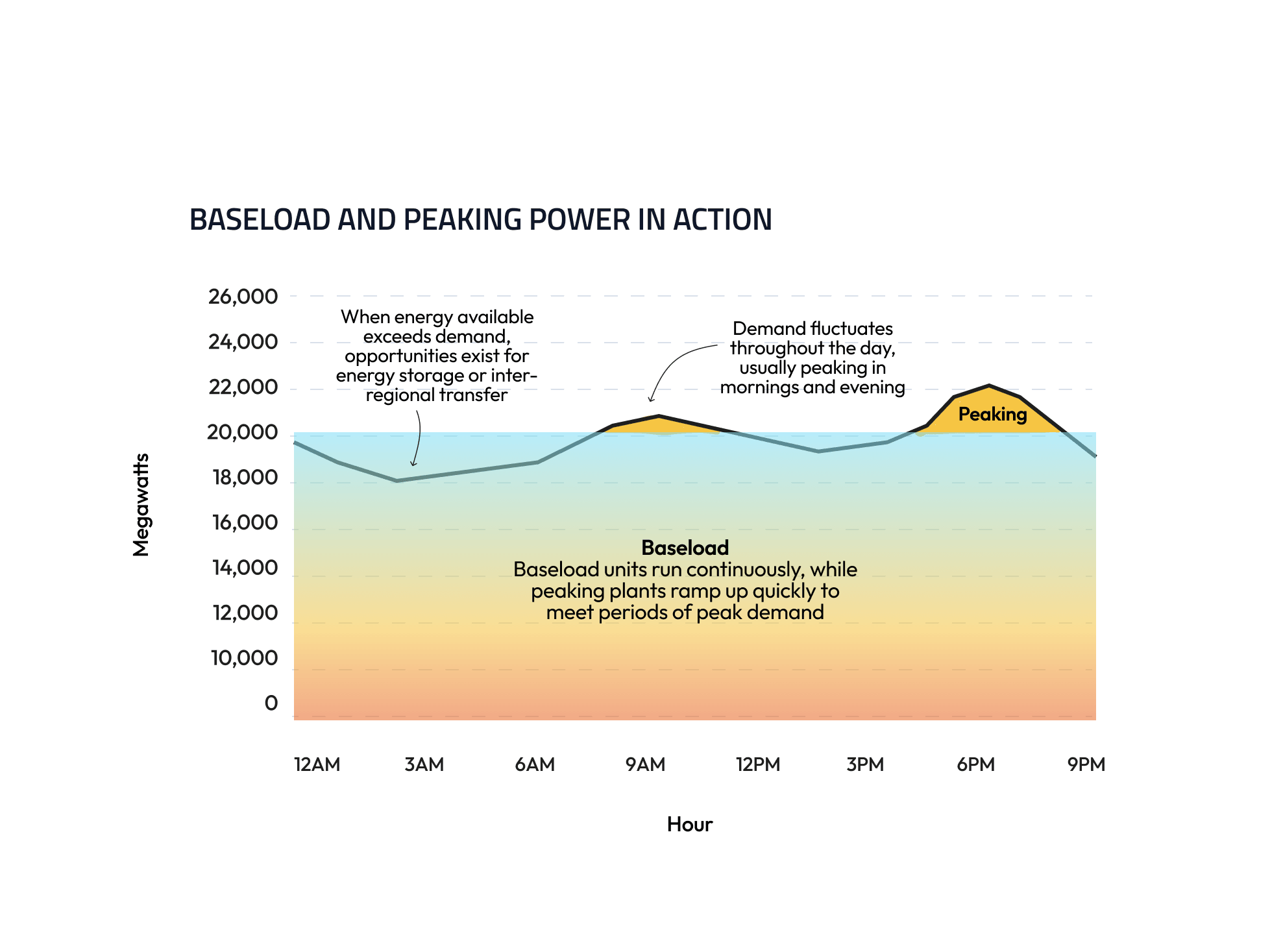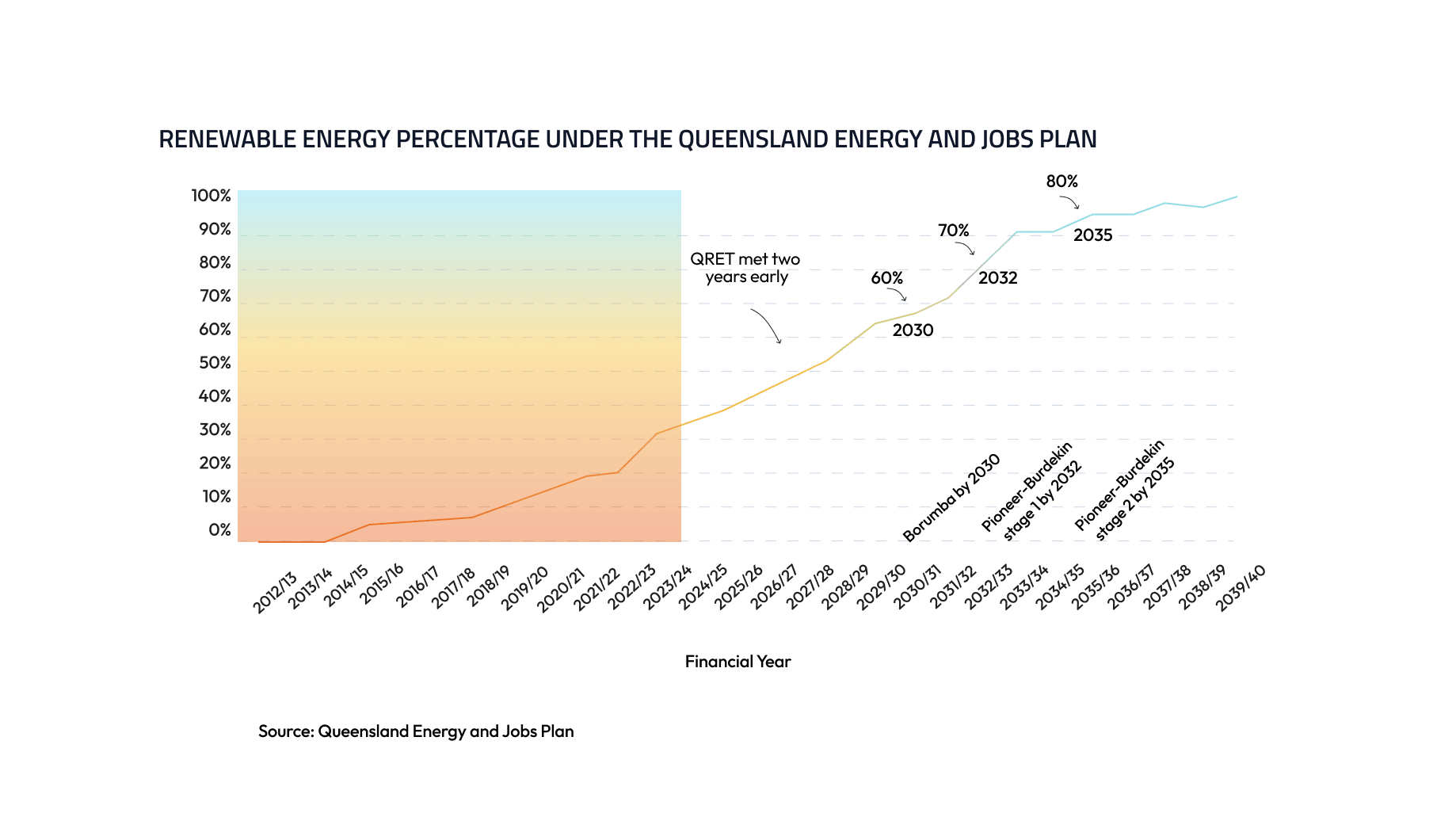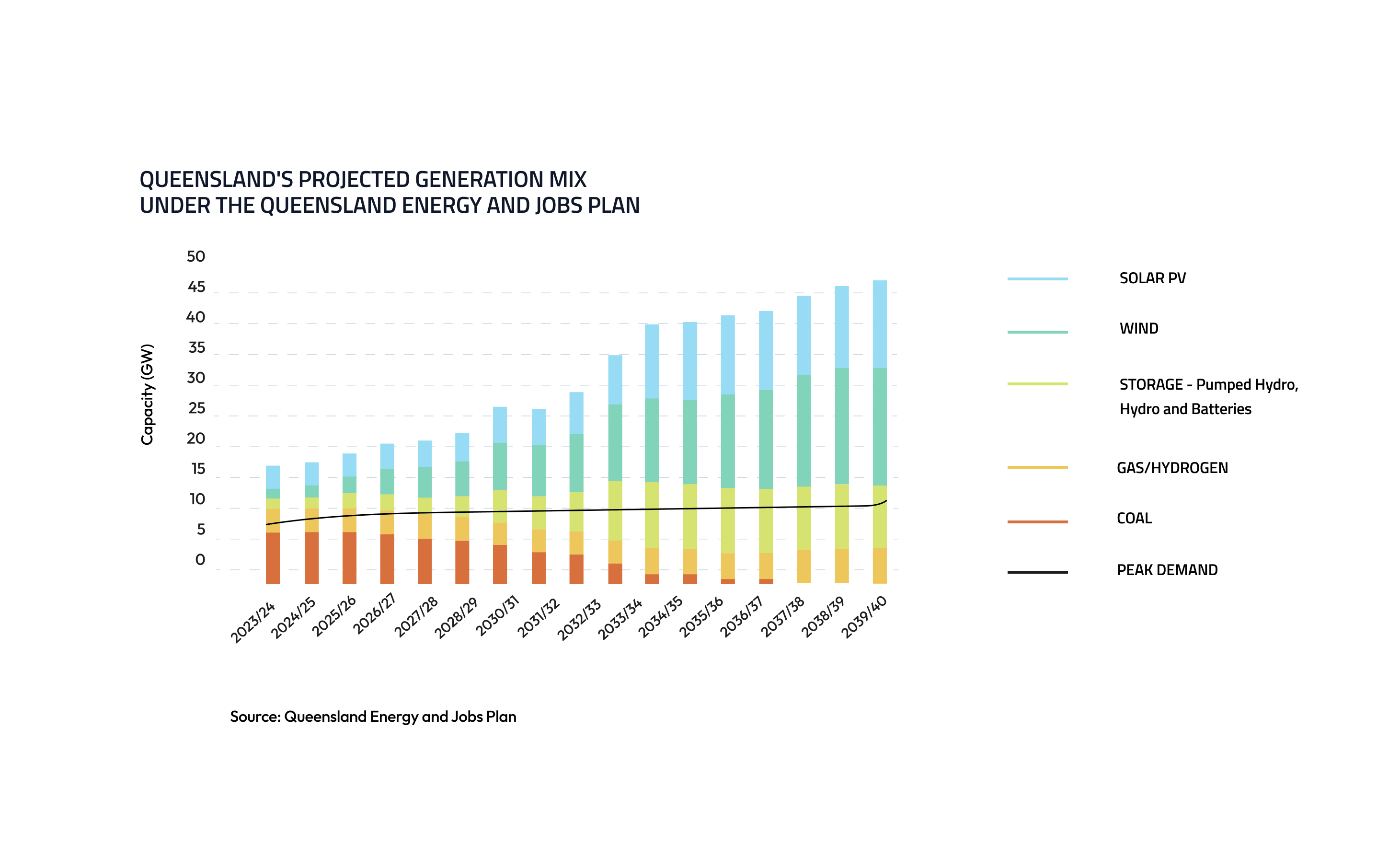Firming the future: Balancing supply and demand as the energy grid evolves
Firming the future: Balancing supply and demand as the energy grid evolves
As Queensland moves towards its renewable energy target, firming the grid – balancing supply and demand against the intermittent nature of renewable resources – will become increasingly important. Here’s how the energy grid will continue to supply reliable, secure, and affordable electricity to consumers as the market evolves.

As Queensland moves towards its renewable energy target, firming the grid – balancing supply and demand against the intermittent nature of renewable resources – will become increasingly important.
Here’s how the energy grid will continue to supply reliable, secure, and affordable electricity to consumers as the market evolves.
How has supply and demand traditionally been balanced?
The NEM commenced operations in 1998 as a wholesale spot market for electricity. From 2009, the Australian Energy Market Operator (AEMO) has managed the centrally coordinated dispatch process, to match the precise balance of supply-demand for electricity in real time.
Generators offer to supply the market with a certain amount of electricity for a particular price for every trading interval. AEMO accepts those offers, starting with the lowest bid offer and working its way up the higher bid offers until enough electricity has been secured to meet demand. The price – measured in dollars per megawatt hour ($ / MWh) – of the marginal megawatt offered, i.e. the last megawatt needed to meet demand for that trading interval, becomes the clearing price for that interval. That price is paid to all generators who are dispatched in that interval.
Dispatchable generation – energy provided by generators that can produce on demand and vary their power output up and down according to market needs, not according to primary energy input availability (e.g. the sun and wind) – has been central to this process. Coal-fired power stations, gas-fired power stations and hydro power stations are current examples of dispatchable generation.
These types of generators are often classified as baseload units and peaking plants, respectively. In Australia, baseload units are typically coal-fired generators, although nuclear power plants also fulfill a baseload role in some countries. Baseload units usually run continuously throughout the year, except during maintenance outages, and currently provide the majority of the power in the energy grid.
Though these units are capable of ramping their production up and down, they tend to move relatively slowly, and cannot operate below certain minimum output levels. Peaking plants, on the other hand, are generators that produce little or no energy during periods of average demand, but can ramp up to full power within minutes during periods of peak demand.

These peaking plants are usually gas-fired generators, which are comparatively low cost to build but more expensive to operate, and typically only run for a few hours at a time. But they play a useful role in the NEM, because demand for electricity peaks for short periods during the day, and from season to season.
When demand is high, these flexible and dynamic peaking plants help to rapidly fill in the difference between the supply from baseload generators and the demand from consumers.
How has the rise of renewables affected this balance?
The rapid rise of renewable resources, such as solar and wind energy, is transforming both the generation mix in the NEM and the way that energy is consumed.
Whereas baseload units and peaking plants provide dispatchable generation, solar and wind generators are intermittent, or variable, because their output is dependent on the weather.
These variable generators are playing a crucial role in reducing emissions, but they provide neither the consistent, ‘always on’ supply of baseload units, or the on-demand capability of peaking plants.
During ‘dunkelflaute’ conditions – a word coined in Europe to describe periods of time when the sun isn’t shining and the wind isn’t blowing – renewable energy generation output is reduced or not available.
The variable nature of wind and solar generation is significant in how it impacts the energy mix and the operation of the system, because we’re seeing a rapid shift to renewables across the NEM.
In Queensland, under the Energy and Jobs Plan, it’s expected that renewable resources will produce 70 per cent of the state’s power by 2032, and 80 per cent by 2035. At the time the Plan was announced in 2022, on average, only 21.4 per cent of the state’s electricity came from renewables.
Under the Plan, 22 gigawatts (GW) of large-scale wind and solar power will be connected to the grid by 2035, adding to the 3GW of large-scale renewables that are already connected and supplying households and businesses with renewable energy.
This additional 22GW includes the Tarong West wind farm to be located 30 kilometres southwest of Kingaroy, which will become Australia’s largest publicly owned wind farm once final approval is obtained.

The transition to renewables is expected to see Queensland reach a 50 per cent reduction in electricity sector emissions on 2005 levels by 2030, and a 90 per cent reduction by 2035-36. (The use of 2005 as a benchmark is in keeping with longstanding emissions targets.)
That’s great news for the environment, but the renewable transition and the gradual retirement of coal-fired generation will have implications for the constant and regular supply of energy to the grid.
In Queensland, these implications are addressed under the Energy and Jobs Plan.
How will supply and demand be balanced in the future?
For supply to continue to closely match demand as the market penetration of wind and solar power increases, there’s a need for firming capacity – a flexible supply of energy that can be called upon instantaneously or over long periods as the wind and solar output constantly changes, or when there’s a sudden increase in demand.
This firming and storage capacity can take several forms.
Intra-day storage absorbs renewable energy throughout the day, stores it, and discharges it later to meet demand. The time between storage and discharge could be minutes or hours. Batteries are ideal for providing intra-day storage.
Long duration storage can discharge stored energy for 24 hours or more during dunkelflaute conditions. Long duration storage, such as pumped hydro energy storage (PHES), plays a key role in managing extended renewable droughts.
Dispatchable and peaking generation, as described above, is generation that can be quickly switched on to provide firming or backup capacity to support variable renewable generation at times of peak demand or during extended renewable droughts.
Transmission interconnection to other states can also provide supplementary firming capacity. Interconnectors are transmission links that join the regions of the NME together, and can transfer generation from other states to Queensland when required.
Based on AEMO’s demand forecasts and energy market modelling, the Queensland SuperGrid Infrastructure Blueprint projects the state will require at least 6,000 MW of long duration storage to support a highly renewable system, complemented by up to 3,000 MW of grid-scale intra-day storage, and up to 3,000 MW of new low-to-zero emission gas-fuelled generation, as well as the existing transmission interconnection from New South Wales, to meet demand.
The Energy and Jobs Plan includes the construction of two large-scale PHES facilities – the Pioneer-Burdekin Pumped Hydro west of Mackay, and the Borumba Pumped Hydro west of Gympie.
The Borumba facility will be able to generate 2GW, enough to provide power for two million homes, but it’s dwarfed by the Pioneer-Burdekin facility, referred to by the Queensland Premier as “the battery of the north”, which is set to be the largest pumped hydro storage facility in the world at (up to) 5GW.
Collectively, the two projects would give Queensland the most hydro storage of any state in Australia.
The Plan also includes a $500 million investment in grid-scale and community batteries to provide intra-day storage. Battery storage also provides an opportunity to build manufacturing capacity in Queensland, and to support more jobs.
And in much the same way that gas-fired plants are currently called upon to provide power at times of peak demand, the Plan includes low-to-zero emission gas generators to provide dispatchable and peaking generation when required.
In the future, it’s expected that Queensland may convert existing gas turbines and install new gas turbines that can be fuelled by renewable hydrogen, or a renewable hydrogen blend, reducing emissions even further.
A 200 MW hydrogen-ready gas peaking power station at Kogan Creek is expected to help firm the grid from 2027. A $20 million commitment to Queensland’s renewable hydrogen hubs and to review the Queensland Hydrogen Industry Strategy in 2023 is also included in the Plan.
If all of the projects proposed under the Plan proceed, the following graph demonstrates how Queensland’s generation mix will transform to include more wind, solar and storage, while ensuring peak demand is always met.

As the above graph demonstrates, Queensland will become gradually less reliant on coal-fired power stations for energy over the next decade. But even when renewable generation and storage is providing the majority of generation in the grid, these stations will continue to play an important role.
Queensland’s publicly owned coal-fired power stations will be converted into clean energy hubs, which will involve installing batteries and/or renewable generation at these sites.
The coal-fired units will only be withdrawn when the newly established Queensland Energy System Advisory Board is confident there is enough replacement generation, storage and supporting infrastructure in place for energy reliability to be assured. In part, this will be achieved by converting some of the coal fired generators into synchronous condensers to provide grid stability services.
To further ensure this, the conversion of some of the coal-fired units to synchronous condensers will be reversible. This will allow those units to return to service if other generators experience forced outages for lengthy periods of time.
Because Queensland’s biggest energy assets are in public hands, the state has unprecedented control and coordination over its destiny – and it’s perfectly positioned to ensure the system remains secure and reliable as it evolves.
Subscribe to our newsletter
STANWELL SPARK
Receive news from Stanwell to your email every quarter and learn more about how we are transforming energy generation.